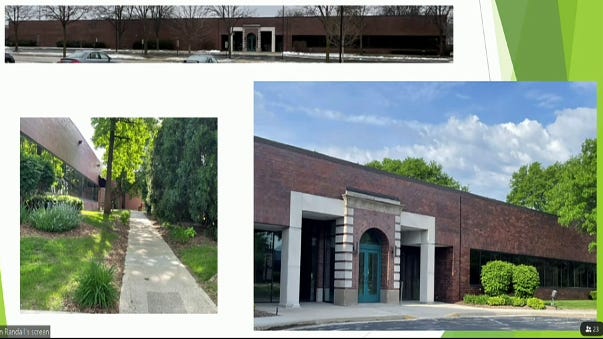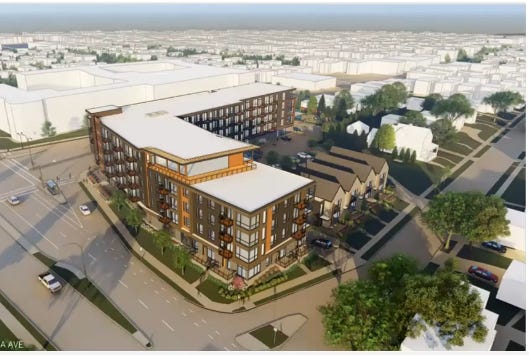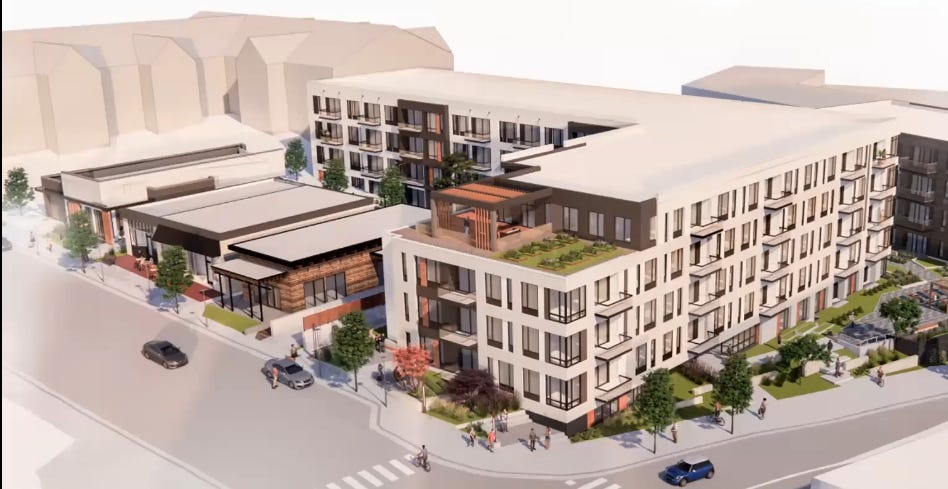Bi-weekly Roundup for the end of July
Improving diversity at WSTEM, fixing Schoonmaker Creek, liquor licenses for gas stations, and traffic.
From the School Board meeting on July 25.
→ A recently-hired Wauwatosa elementary school teacher became the Internet’s punching bag last week when @LibsOfTikTok reposted a picture he’d taken of himself on Instagram holding a coffee mug with the phrase “Ask me about my pronouns” written on it and a caption that said, “We had a great pronoun discussion -First Grade teacher @TosaSchools.”
The online response was about what you’d imagine1. The Journal-Sentinel has an article if for some reason you can’t imagine. During the School Board meeting itself, one woman stood up during the Public Comment period to register her displeasure about teachers having discussions about gender-ideology with first-graders. A number of other parents and teachers then stood up to say that they’re very happy to have this teacher employed in the Wauwatosa School District and that it’s a shame some people are so ignorant and intolerant.
Number of times the word “grooming” was used: 2
→ Expenditures. The School Board unanimously approved the purchase of new computers for some of its digital media labs and subscription renewals for digital textbooks, Microsoft Office for the District, Blackboard (a platform that manages the district’s website as well as mass notifications), and EDIS (for analyzing administrative data). Total cost: $270,997.69
→ Teacher Retention. The District’s new Chief of Talent, Sarah Zelazoski, gave an update on teacher retention issues. The district is seeing about 15% turnover and finds that the reasons are mostly what you’d expect:
As we try to think about and learn more about why employees leave organizations, the research really pre- and post-Covid are very consistent in terms of the reasons employees leave, and there are three primary reasons: One is that employees don't care for or feel respected by their supervisor. Another is that they feel that they're limited in their opportunities for advancement. And the third is that […] they want to have opportunities for higher wages.
Although the District’s participation rate for exit surveys is only 60%, the responses they received are fairly consistent with the above. Supervisors can't resolve their complaints and concerns, and they don’t feel they’re being recognized for their accomplishments.
There was discussion among board members on potential ways to increase the pipeline of new teachers and improve retention which the District will pursue more fully in its strategic planning sessions.
→ From the Consent Agenda.
This month’s most expensive new hire: $82,481 for a Secondary Mental Health Specialist at Wauwatosa West High School. This is a new position funded with ESSER grant money.
This month’s most expensive business service: $34,605 for the annual license renewal of Skyward, the District’s Finance and Human Recourses management software. This narrowly beat out the $34,166.26 paid for 54 two-way radios from Alpha Prime Communications.
→ Wauwatosa STEM. Principal Mike Heun and Governance Board President Justin Dux gave their annual report on WSTEM. In the building it shares with Wilson Elementary school, the school enrolls 136 students of whom 73 are male, 85% are white, 10 are Special Education students, 14 are economically disadvantaged, and 11 are open enrollment.
The Board was very fulsome in its praise of student achievement at WSTEM, with the school achieving much higher math and reading proficiency levels and scoring 97.2 on their Department of Public Instruction report card compared to 79.6 at Wilson and 74.4 across the district as a whole. Most of the ensuing discussion revolved around how to capitalize upon this success and transfer some of the lessons learned to other schools in the district.
I might write about this more since I think it’s interesting and underappreciated, but I would imagine that most of the outperformance of WSTEM students relative to Wilson and the wider school district is due to selection effects despite admission being based on a lottery. I suspect that attempts to replicate their success across the district won’t lead to much, because the population of parents and children who apply for the lottery are significantly different than those who don’t.
Relatedly, I found this exchange between Board Member Jennifer Hoag and the WSTEM principal, as everyone was brainstorming ways to increase diversity at the school, kind of funny:
Board Member Hoag: Has there been any discussion or consideration of just intentionally enrolling non-white students to sort of move that process forward instead of doing the […] lottery that other students go through?
Mike Heun, after making sure he heard her correctly: …By law we can't allocate spots just for one particular race and/or gender.
That does indeed sound illegal.
From the Community Affairs meeting on July 26
→ Proposed Zoning Amendment. The Druml Company, a Wauwatosa-based Real Estate firm, bought the former Northwestern Publishing House Christian Books and Gifts building in 2018. Located at 113th and Watertown Plank Rd., it’s near Empire Fish and Bostik, “a world leader in the manufacture and supply of specialty adhesives and sealants.” The building is zoned M2, or heavy manufacturing, but unfortunately, they can’t find a manufacturer to rent it because the ceilings are too low to manufacture things and there’s not enough loading docks to ship them anywhere even if they could.

But the Druml Company has gotten some interest from a few medical businesses that could potentially use it for office space, therapy, or as an outpatient clinic. You’re not allowed to use a heavy manufacturing-zoned parcel for a medical office or a clinc, so they’d like the Common Council to amend the zoning code to add it as a conditional use. The Planning Commission wasn’t impressed when they pitched the idea to them last month, and they recommended denying the request. But this time around, Brian Randall, the attorney representing the Druml Company, made sure to emphasize:
This used to be a tax-exempt property but is tax-exempt no longer, so if they can rent it out, it would contribute revenue to the City.
It’s only a request for a conditional use not a permitted use, so it would still have to come before the Common Council for approval before they could put a medical office there [pro-tip: always emphasize that local elected officials will still have the power to deny something].
Don’t worry, the text of the zoning amendment specifically excludes putting an urgent care facility, ER, or drug rehab center here.
Do you want this thing rented or not? No one’s putting a factory in here.
I’m not sure what Mr. Randall said to the Planning Commission last month, but most of the Community Affairs committee—with the exception of Ald. Makhlouf—seemed pretty gung-ho about the whole thing.
Ald. Makhlouf worried about all the additional traffic from patients coming in and out, but Ald. Dubinski said he’s been watching that area develop since the 1970s—“It used to be a nice wooded area north of Empire Fish. It was very popular with the dog walkers”—and there’s no way traffic is going to be a problem. It’s a manufacturing district so trucks are always going in and out of there anyway, the place used to be a FedEx office, it’s across the street from a Walgreen warehouse facility, and one person showing up every hour for their shoulder rehab appointment isn’t going to make a difference.
Ald. Makhlouf appeared convinced. The zoning text amendment was unanimously recommended for approval.
→ Schoonmaker Creek. City Engineer Bill Wehrley gave a presentation on potential options to improve drainage within the Schoonmaker Creek watershed.
In a previous article I wrote:
When it rains heavily, the small sewer pipes and open channel aren’t large enough to transport all the water along its length and into the Menomenee River. The water begins to back up, flooding streets and basements.
Increasingly heavy rainfall has left streets near 74th and Center, 68th and North, 66th and Llloyd, and 62nd and State under feet of water that necessitates closing the interesections to vehicle traffic. The City would like to fix this.
A previous study completed by the Milwaukee Metropolitan Sewer District (MMSD) and the Southeastern Wisconsin Regional Planning Commission (SEWRPC) identified sixteen potential solutions to improve drainage in the region (not just Wauwatosa). After removing options that would be inadequate to reduce flooding to the level the City wanted, involved MMSD upgrading their own pipes which they already said they’re not going to do, required the City to build and operate a dam, or involved the creation of retention ponds in parts of the Washington Highlands neighborhood, Mr. Wehrley was left with three options he considered worthy of further investigation.
Option 15 and 16 involved boring a giant tunnel 50 feet or so underground to divert water into the Menomonee River while option 6 involved expanding the size of the culvert going through the Washington Highlands neighborhood (picture above). The Public Works Department wanted the Common Council’s approval to hire consultants to examine these three alternatives in more depth over the next 1-2 years.
At this point a dozen residents of the Washington Highlands marched to the microphone to express their extreme displeasure with option 6 mostly because they worried kids were going to drown, that it’d be really ugly, and that the water runoff is already pretty gross and they didn’t need any more hypodermic needles in their yards. They all requested it be removed from consideration entirely.
Only a single, lone civil engineer suggested that perhaps it would be a bad idea to only investigate two options for a potentially $100M capital improvement project, but in the end the committee removed option 6 and recommended only options 15 and 16 for further consideration. The Common Council will make the final decision on August 2.
I think I’ll write about this a little more next week, but I was surprised by this. How much time and money are we saving by not looking into it? No one asked. What if a study determined that option 6 only cost half as much as the others? A quarter? It’s not that I think these are likely estimates, but the problem wasn’t even considered in those terms.
From the Government Affairs meeting on July 26
→ Selling beer at gas stations. Will the Common Council allow a gas station operator to sell beer? Surprisingly contentious. David Roettgers wants to, because it’ll increase the revenue at his Tosa Mobile on North Avenue and every surrounding municipality allows it, so what’s the big deal?
Ald. Franzen says, Yeah, what is the big deal between a gas station and Pick N Save?
Ald. Makhlouf says, Come on, everybody is doing it. We need to get with the times.
But Ald. Tilleson worries about setting a precedent. Is every convenience store or gas station owner going to be applying for a liquor license now?
And Ald. Arney worries about it attracting more crime though seems convinced by Mr. Roettgers assurance that people mostly just steal cigarettes and money.
At this point, Mayor McBride strolls to the microphone and says, You bet it’s going to increase crime! And if we allow him to sell beer, every gas station and convenience store operator is going to be asking to do the same. I tried to warn everyone about this exact issue when CVS wanted to sell alcohol—immediately after we allowed it, Walgreen wanted to sell it too. And people are always stealing liquor from these stores.
[For the record, I always appreciate these arguments from historical experience. Like when the Mayor talks about being a paperboy in the 1970s when the John Birch Society would protest the City flying the UN flag. Or when Ald. Dubinski recounts the history of a plot of land going back to a time before many of the other alders were born.]
Ald. Makhlouf asks Chief McGillis what he thinks about all this.
Chief McGillis politely declines to recommend a course of action but says they’ll continue to respond to whatever calls for service they get.
The Government Affairs committee voted 5-3 to deny the request for a liquor license to Mr. Roettgers
→ Ald. Meindl’s Anti-SWATting Bill. According to the memo Ald. Meindl submitted, “Swatting is the action or practice of making a prank call to emergency services to bring about the dispatch of a large number of armed police officers to a particular address.” As you might imagine, sometimes the prank goes horribly wrong and the SWAT teams end up shooting or killing an innocent person. Public figures and minor celebrities, like Twitch streamers and Youtube influencers, are often the targets of SWATting attempts, and Ald. Meindl would like to protect them.
He would like Wauwatosa residents who are worried about being SWATted to be able to fill out a form with the Police Department so that an informational flag pops up in the 911 Emergency Management System if someone reports a crime at their residence.
Unfortunately, it became clear that Ald. Meindl wasn’t really sure how the Wauwatosa Police Department’s EMS system worked—because he said as much—or whether it was possible to add these types of warnings. Chief McGillis was also kind of confused about what he was being asked to do but gave an overview of the relevant laws, city ordinances, and Department Standard Operating Procedures that he felt mostly accomplished the things Ald. Meindl was worried about.
Ald. Tilleson, Chair of the Government Affairs committee, concluded:
I think this is premature […] to introduce a policy when the parties haven’t even talked about if there’s even room for a policy.
Ald. Fuerst agreed, adding:
I do have to agree that I do feel like I kind of sat here listening in on a private meeting instead of a discussion.
The committee thanked Ald. Meindl for bringing attention to the issue but agreed that it would be put on hold so he could coordinate with the Police Department and devise a policy they both supported.
From the Financial Affairs meeting on July 26
→ New Housing. Cornerstone Village and Harlow & Hem, two multi-unit residential apartment buildings, gave brief presentations to the Financial Affairs committee before entering into closed session to discuss the terms of the City’s agreement to provide partial funding for their projects. Partnering with the City has allowed both developments to include affordable housing.
Cornerstone Village will have 90 apartments and 4 townhomes. Twent-four of these units are set aside for the mentally disabled, and 19 of those units will be affordable.
9 apartments will be priced for a 1-person household making 50% of Area Median Income (AMI) ($29,550). Rent would be approximately $786 per month.
7 apartments will be priced for a 1-person household making 60% AMI ($35,460) Rent would be approximately $943 per month.
3 apartmentswill be priced for a 1-person household making 80% AMI ($47,250). Rent would be approximately $1,257 per month.
The first level of the complex will contain a food or beverage establishment that will employ some of the mentally disabled tenants, a life skills center, and a BMO Harris bank branch.

Harlow & Hem will have 15 studio apartments, 58 1-bedroom apartments, 43 2-bedroom apartments, and 14 3-bedroom apartments. Twenty-six of these apartments will be for workforce housing which means they’ll be rented at below-market rates.
22 will be priced at rates affordable for individuals at 80% AMI and
4 studios will be priced at rates affordable for individuals at 30% AMI.

Before entering into closed session, committee members mainly seemed concerned about traffic, how much parking there will be, whether the public can access it, how they will access it, traffic, whether it’s safe for residents to park there because the public can access it, how the snow in the parking lots will get plowed, and traffic.
As someone who has never been curious about these things and just assumed that the developers trying to make money have an incentive to figure this out without much external prompting, I am starting to think that either:
Traffic patterns and parking lot layouts are intrinsically fascinating subjects to many people, and I am unusual in my level of disinterest,
Developers will totally put vehicle entrances and exits in ridiculous places that make no sense and routinely forget that it snows in Wisconsin, or
Something like 90% of the email local elected officials receive from residents consists of complaints about too much traffic, a lack of available parking, and armchair-theorizing about the effects of new development on both.
Have a good weekend!
On a side note, Twitter has this great feature where, if you’re reading anonymously and start scrolling through tweets, a sign-in screen will eventually pop-up and you won’t be able to read anything more until you login. That’s when I close Twitter.





Thanks for your usual informative and insightful newsletter!
The discussion of STEM success due to selection bias is a great point, thanks for the research.